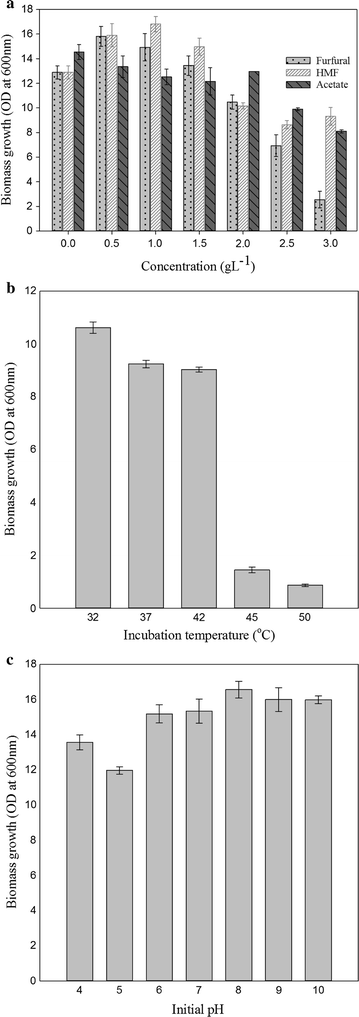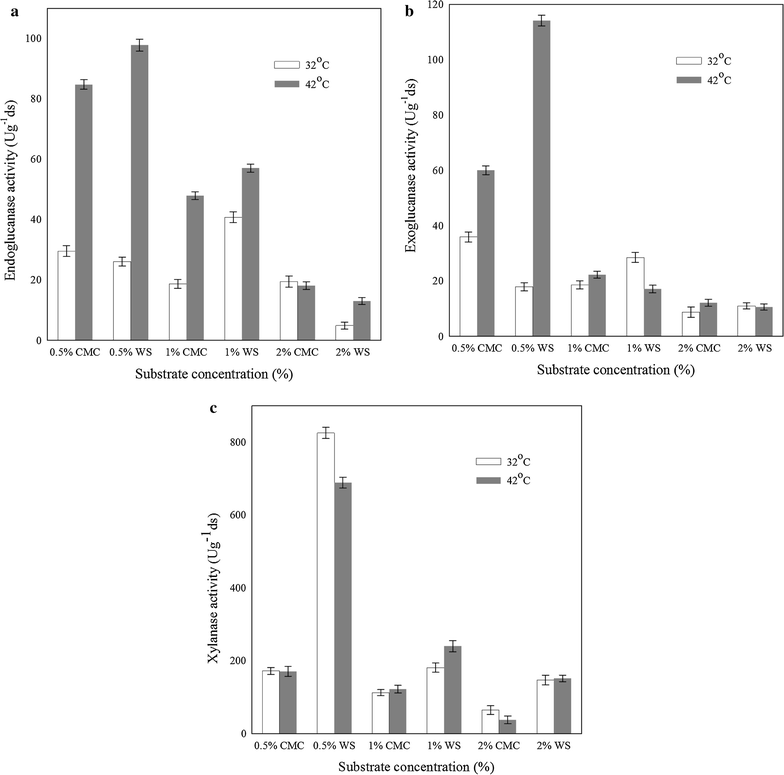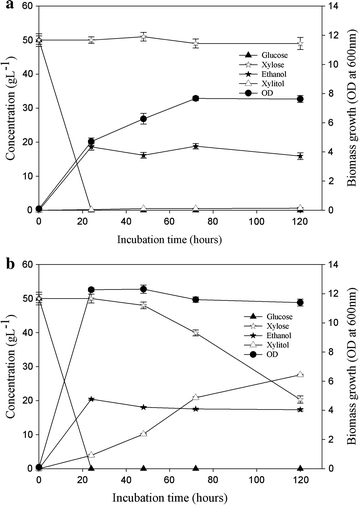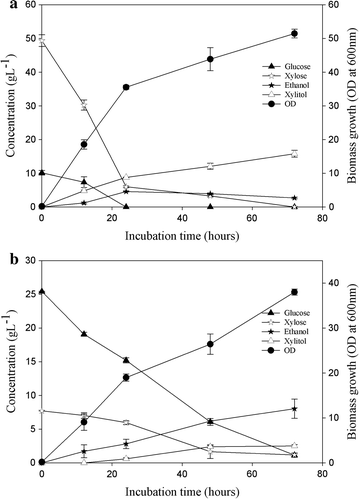Cellulolytic enzyme expression and simultaneous conversion of lignocellulosic sugars into ethanol and xylitol by a new Candida tropicalis strain
- PMID: 27462368
- PMCID: PMC4960679
- DOI: 10.1186/s13068-016-0575-1
Cellulolytic enzyme expression and simultaneous conversion of lignocellulosic sugars into ethanol and xylitol by a new Candida tropicalis strain
Abstract
Background: Lignocellulosic ethanol production involves major steps such as thermochemical pretreatment of biomass, enzymatic hydrolysis of pre-treated biomass and the fermentation of released sugars into ethanol. At least two different organisms are conventionally utilized for producing cellulolytic enzymes and for ethanol production through fermentation, whereas in the present study a single yeast isolate with the capacity to simultaneously produce cellulases and xylanases and ferment the released sugars into ethanol and xylitol has been described.
Results: A yeast strain isolated from soil samples and identified as Candida tropicalis MTCC 25057 expressed cellulases and xylanases over a wide range of temperatures (32 and 42 °C) and in the presence of different cellulosic substrates [carboxymethylcellulose and wheat straw (WS)]. The studies indicated that the cultivation of yeast at 42 °C in pre-treated hydrolysate containing 0.5 % WS resulted in proportional expression of cellulases (exoglucanases and endoglucanases) at concentrations of 114.1 and 97.8 U g(-1) ds, respectively. A high xylanase activity (689.3 U g(-1) ds) was also exhibited by the yeast under similar growth conditions. Maximum expression of cellulolytic enzymes by the yeast occurred within 24 h of incubation. Of the sugars released from biomass after pretreatment, 49 g L(-1) xylose was aerobically converted into 15.8 g L(-1) of xylitol. In addition, 25.4 g L(-1) glucose released after the enzymatic hydrolysis of biomass was fermented by the same yeast to obtain an ethanol titer of 7.3 g L(-1).
Conclusions: During the present study, a new strain of C. tropicalis was isolated and found to have potential for consolidated bioprocessing (CBP) applications. The strain could grow in a wide range of process conditions (temperature, pH) and in the presence of lignocellulosic inhibitors such as furfural, HMF and acetic acid. The new yeast produced cellulolytic enzymes over a wide temperature range and in the presence of various cellulosic substrates. The cellulolytic enzymes produced by the yeast were effectively used for the hydrolysis of pretreated biomass. The released sugars, xylose and glucose were, respectively, converted into xylitol and ethanol. The potential shown by the new inhibitor tolerant cellulolytic C. tropicalis to produce ethanol or xylitol is of great industrial significance.
Keywords: Candida tropicalis; Cellulase; Ethanol; Wheat straw; Xylanase; Xylitol.
Figures





Similar articles
-
Xylitol production on sugarcane biomass hydrolysate by newly identified Candida tropicalis JA2 strain.Yeast. 2019 May;36(5):349-361. doi: 10.1002/yea.3394. Yeast. 2019. PMID: 30997699
-
Continuous co-production of ethanol and xylitol from rice straw hydrolysate in a membrane bioreactor.Folia Microbiol (Praha). 2016 May;61(3):179-89. doi: 10.1007/s12223-015-0420-0. Epub 2015 Sep 9. Folia Microbiol (Praha). 2016. PMID: 26354791
-
Aerobic and sequential anaerobic fermentation to produce xylitol and ethanol using non-detoxified acid pretreated corncob.Biotechnol Biofuels. 2014 Nov 23;7(1):166. doi: 10.1186/s13068-014-0166-y. eCollection 2014. Biotechnol Biofuels. 2014. PMID: 25431622 Free PMC article.
-
Bioconversion of lignocellulosic biomass: biochemical and molecular perspectives.J Ind Microbiol Biotechnol. 2008 May;35(5):377-391. doi: 10.1007/s10295-008-0327-8. Epub 2008 Mar 13. J Ind Microbiol Biotechnol. 2008. PMID: 18338189 Review.
-
Review of Second Generation Bioethanol Production from Residual Biomass.Food Technol Biotechnol. 2018 Jun;56(2):174-187. doi: 10.17113/ftb.56.02.18.5428. Food Technol Biotechnol. 2018. PMID: 30228792 Free PMC article. Review.
Cited by
-
Biorefinery cascade processing for creating added value on tomato industrial by-products from Tunisia.Biotechnol Biofuels. 2016 Dec 1;9:261. doi: 10.1186/s13068-016-0676-x. eCollection 2016. Biotechnol Biofuels. 2016. PMID: 27980671 Free PMC article.
-
Expression of cellulase in Candida glycerogenes and strengthen the expression level for application in residue-containing fermentation to enhance glycerol production.Biotechnol Lett. 2025 Jun 27;47(4):68. doi: 10.1007/s10529-025-03602-7. Biotechnol Lett. 2025. PMID: 40576732 Review.
-
Interdependence between lignocellulosic biomasses, enzymatic hydrolysis and yeast cell factories in biorefineries.Microb Biotechnol. 2022 Mar;15(3):985-995. doi: 10.1111/1751-7915.13886. Epub 2021 Jul 21. Microb Biotechnol. 2022. PMID: 34289233 Free PMC article. Review.
-
Characterization of Zalaria obscura Y1223 hydrolases: implications for lignocellulose conversion.AMB Express. 2025 Jul 23;15(1):109. doi: 10.1186/s13568-025-01907-4. AMB Express. 2025. PMID: 40699489 Free PMC article.
-
Fermentation Process and Metabolic Flux of Ethanol Production from the Detoxified Hydrolyzate of Cassava Residue.Front Microbiol. 2017 Aug 22;8:1603. doi: 10.3389/fmicb.2017.01603. eCollection 2017. Front Microbiol. 2017. PMID: 28878755 Free PMC article.
References
-
- Limayem A, Ricke SC. Lignocellulosic biomass for bioethanol production: current perspectives, potential issues and future prospects. Prog Energ Combust. 2012;38:449–467. doi: 10.1016/j.pecs.2012.03.002. - DOI
LinkOut - more resources
Full Text Sources
Other Literature Sources

